| 1 | Black racer |
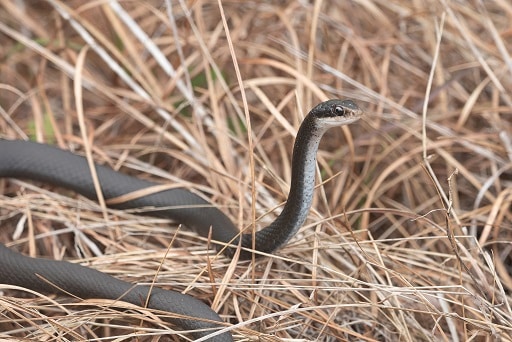
Though Florida is infested with snakes, the likes of timber rattlesnakes and southern hognose snakes stay within their comfortable sandy woodlands, and refuse to leave their borders. The black racer is the most likely to slither through the roads of a holiday complex, through the security-locked gate, across the warm tiles, and directly into a swimming pool, to the shock of the people swimming in it.
The black racer has no worries about invading human habitation, as they’re regularly found in suburbs and even outside Walmart. This flexibility extends to the holiday resort and pool near Disney World your family has been dreaming of. They don’t care about chlorine, and they don’t care about the clubhouse security guard. Black racers measure up to 2 metres and are extremely fast. While non-venomous, they have a vicious bite, and tend to aim for the face if held.
If any snake in Florida would slither beneath poolside deck chairs and send the people on them scattering, it’s the black racer. Alternatively, they might be so sleepy or so absorbed in their books that they don’t notice the snake. Before the security guard can arrive, the black racer might slither up the metallic fence and into the forest on the other side.
| 2 | Golden crowned snake |
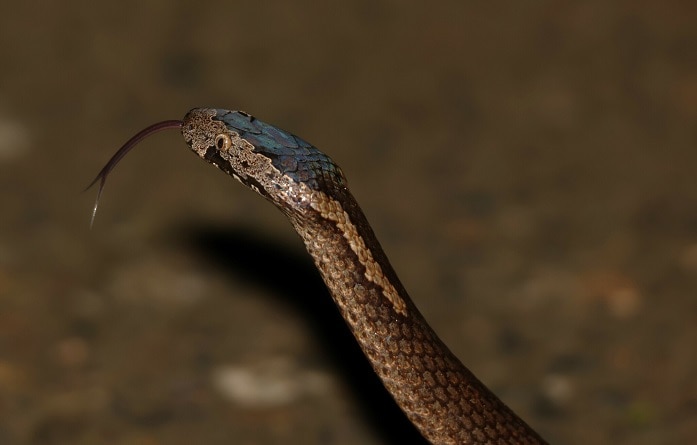
The golden crowned snake is a mildly venomous species of eastern Australia measuring 50cm, maximum 95cm. This snake is dependent on moisture rather than dry outback. In the wild, they thrive in rainforests and schlephoryll forests. In suburban Sydney and Brisbane, they’re usually found close to water sources, and this includes the safe haven of swimming pools.
Golden crowned snakes may fall into swimming pools accidentally, or be lured by the promise of cool moisture. They don’t care if the pool is full of swimmers, although with their poor snake eyesight, they probably wouldn’t notice until they came face to face with someone anyway.
There’s no master plan with golden-crowned snakes. They’re lured close to swimming pools opportunistically, and they may not realise they’re trapped until it’s too late. Away from swimming pools, some of their favourite spots in suburbs are puddles that form after downpours. In one case, a golden crowned snake was found in a pool and felt very limp when handled, as though nearly dead (perhaps due to chlorine). But it then reactivated with a tongue fleck, and all was well.
| 3 | Banded watersnake |
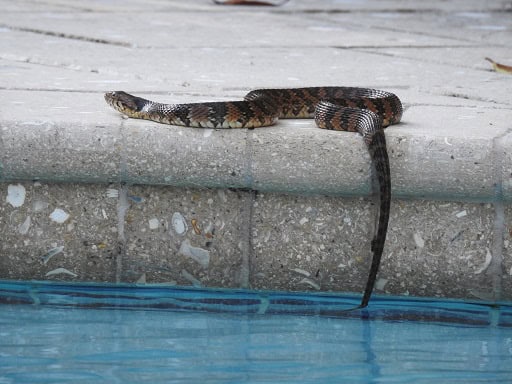
Any member of the Nerodia watersnake family is a candidate to appear in swimming pools, and the banded watersnake (Nerodia fasciata) has been caught many times. This species measures 55-105cm, and is recognisable by alternating black and orange bands. In a few rare morphs, the orange takes over to dominate the black.
States where the banded watersnake could ruin your carefully planned vacation include Florida, Georgia, South Carolina and Alabama. Banded watersnakes are most likely to stray in if your swimming pool is directly next to a large lake. Perhaps the Nerodia fasciata was in there for months, swimming happily along the shores until its food supply grew scarce. This forced it to become more adventurous and seek new water bodies, not realising that the next one was chlorinated and artificial. The next minute, it’s causing tourists to scatter, some of whom are probably too exhausted to move after a day at a waterpark.
Beware of this snake, as while it lacks even a mild venom, all Nerodia watersakes can be vicious and bitey if picked up. If you swim past one calmly, you’ll probably be OK, if you hold your nerve. It’s touch they can’t stand.
| 4 | Red-necked keelback |
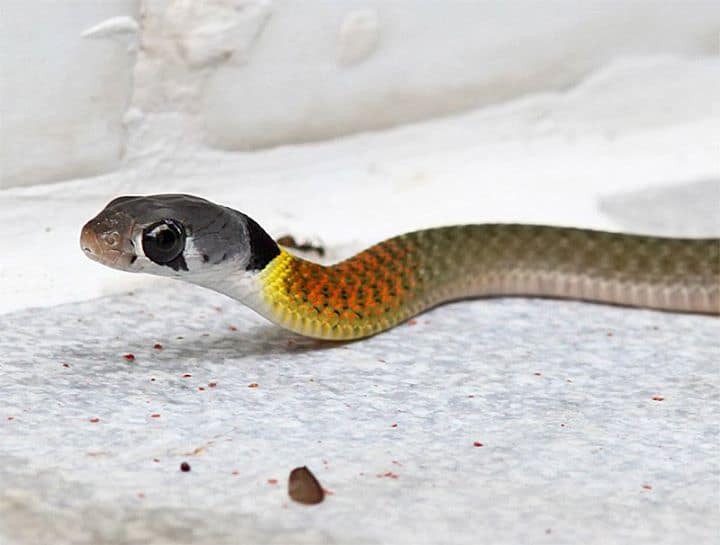
Perhaps the most likely snake to meet in a Thailand swimming pool. Red-necked keelbacks combine several of the necessary features. Firstly, they’re a water-loving snake which isn’t fully aquatic, inhabiting small pools, drainage ditches, and puddles which fill up post heavy rainfall. However, they’re also more comfortable in urban areas than some of their kin, like the blue-necked keelback, which only inhabits remote mountain forest streams.
Red-necked keelbacks are abundant in Thailand and measure 45-75cm. This is a rare snake to be simultaneously venomous and poisonous, wielding a standard toxin elixir through their teeth, but also stored toad toxins originating from their diet, with which they can blast people from a special neck gland.
Red-necked keelbacks likely head for pools in search of this frog prey, enter, then realise that there’s only large hairless ape creatures swimming around. This is one snake you should never try to rescue from a pool, even if it’s fully bordered with steep sides. A hasty grab for its tail could result in a spray of toad toxins directly in your eyeball. If a red-necked keelback enters your pool, then evacuate. There’s no time for nonsense with this dangerous species. Fortunately, their signature neck marking makes them easy to identify.
| 5 | Montpellier snake |
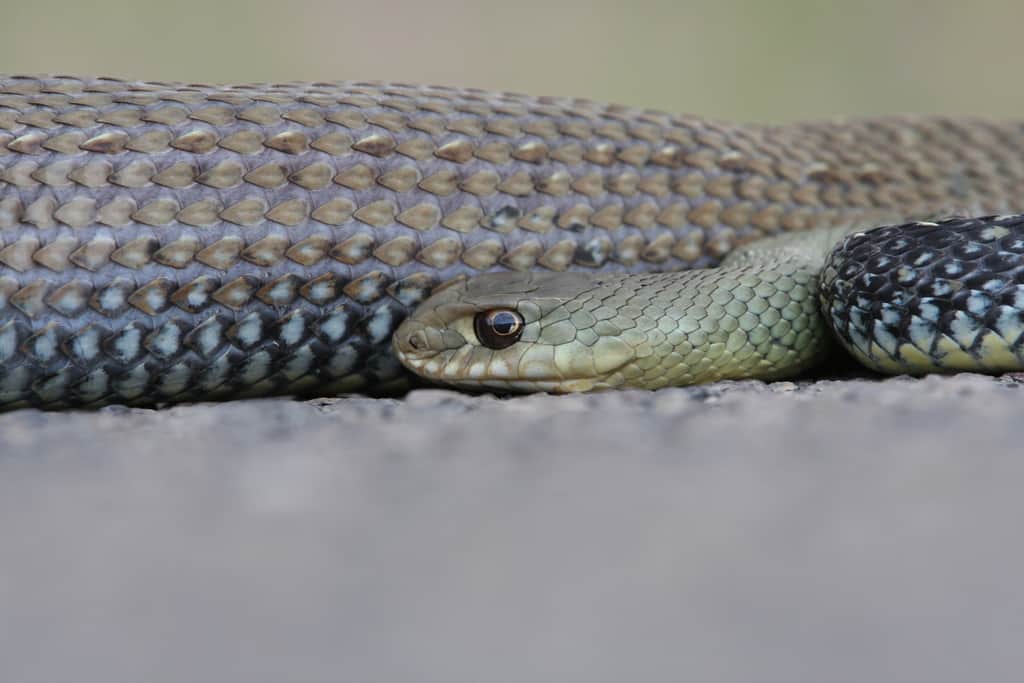
The most likely snake that Spanish tourists will meet by a swimming pool. This species inhabits virtually all of Spain and Portugal, and is exceptionally flexible and inventive. They even hang out at rubbish tips and dumps waiting for rat colonies to swarm in, so a swimming pool is clearly no problem.
In the action-packed life of a Montpellier snake, a swimming pool is just another obstacle to be brushed aside. They probably don’t notice the panicked tourists fleeing, splitting down the centre like the parting of the dead sea. Montpellier snakes just care about their mission of satisfying their hunger and finding a secure place to coil up that night.
This is a long snake measuring up to 2.5 metres, the longest in Spain. Swimming is no issue for them, with powerful side to side writhing that generates huge velocity. Don’t be surprised to see a Montpellier snake resting calmly in the shallow end one minute, then hurtling towards you at full speed the next. Montpellier snakes are venomous, but have very tiny mouths, which can only cause harm if you poke your finger inside.
| 6 | Pygmy rattlesnake |
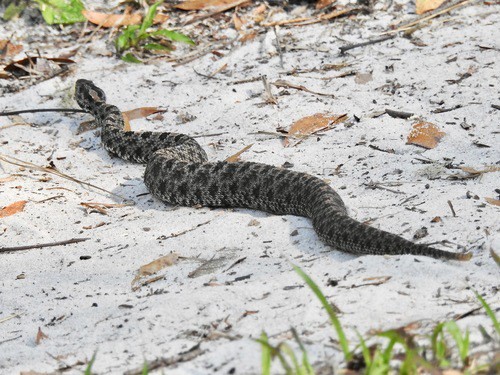
There’s no doubt that if you wish to seek refuge from the millions of rattlesnakes prowling the USA, a swimming pool is better than a forest. But even the most impenetrable fortress isn’t invulnerable against rattlesnakes, and the pygmy rattlesnake (Sistrurus miliaris) proved this in a case from 2012. Wayne Wilburn and his family had arrived at Windsor Hills Resort south of Orlando that afternoon, and went for an immediate swim, only for Wilburn to be bitten, after attempting to fight the poolside rattler off with a stick. He survived, but required 3 vials of antivenom.
Pygmy rattlesnakes generally inhabit forests with plenty of fallen timber, but also gravitate to water bodies within them. A swimming pool directly next to a forest may be a risk in Florida, perhaps if your gated holiday community is the last in a row of them, and borders the area where the Florida wilderness kicks in again.
This forest could be clearly visible from the civilised swimming pool, as a disturbing reminder that the danger of Florida’s wilderness is never too far away. The thought of the menacing, writhing creatures slithering through the undergrowth just a few hundred metres away over the lake might become too much to handle. The swimming pool might become a place of nightmares rather than relaxation, even if the pygmy rattlesnakes are too lazy to cross over in reality (as they tend to move less than 5 metres per day).
| 7 | DeKay’s brown snake |
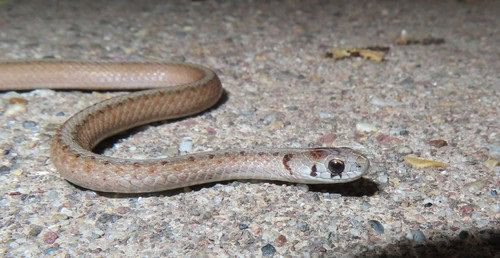
Of all US snakes, Dekay’s brownsnake (Stoeria dekayi) has to be the most surprisingly common to find in swimming pools. Numerous owners and tourists have scooped this small 20cm snake out and inquired to the internet about which species they’re holding, including citizens of Arkansas, North Carolina and Kansas. This is a small, humble snake, which is completely non-venomous and lacks any dangerous teeth. Their main prey is earthworms, and they’re a highly likely snake to appear in urban areas, including your garden. This extends to the chlorinated delights of swimming pools.
Although DeKay’s brown snakes are completely harmless, your fellow tourists might not know that. If you’re lucky, the appearance of Storeria dekayi might cause a mass panic where everybody flees the pool, from toddlers in the shallow end to a middle aged woman on a lilo in the deep end. The next minute, you have the entire pool to yourself, having coincidentally forgotten to tell everyone which species it was.
However, we don’t recommend actually scooping one up and dumping it in the pool when nobody’s looking. Firstly, you’d have to find one, which would be easy normally, but probably incredibly difficult when you actually needed one. Secondly, if a pool is busy, then by definition you’re more likely to be spotted hiding the snake in your towel or beach shorts.
| 8 | Yellow-faced whipsnake |
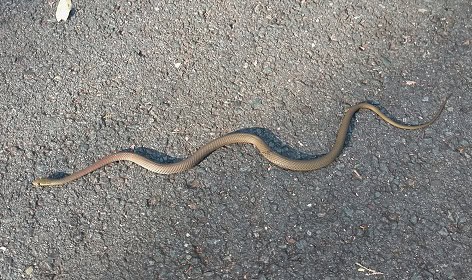
Yellow-faced whipsnakes (Demansia psammophis) are an extremely common snake in suburban Sydney, glaring at people from brick walls, slithering down the opposite side when confronted, and slithering confidently down hot pavements. This urban nature has led many reptile rescuers to pull them out of people’s swimming pools before, whether at hotels or private property.
This is a non-venomous snake measuring 80cm, which is adventurous and active rather than sedentary. They lack any caution, thus bringing them to people’s pools, as they investigate the predatory possibilities of the nearby tiles and bushes.
Theoretically, there’s no reason against sharing a pool with this snake. You could train the breaststroke at one end, and the snake could float harmlessly in the shallow end, pondering its next move. Everyone else might evacuate while you use your superior knowledge to remember that they’re non-venomous.
The problem is their extreme speed. Yellow-faced whipsnakes are very start-stop, staying still, then reactivating and blasting off faster than a human’s walking pace. If you were swimming at the deep end, and you suddenly saw Demansia psammophis swimming towards you at top speed, then let’s face it: your previous resolve to stay in would probably melt away, and you’d be scrambling up the sides, hoping it didn’t get to you in time. There might be one guy in the pool with no fear, laughing at everyone else.
| 9 | California kingsnake |
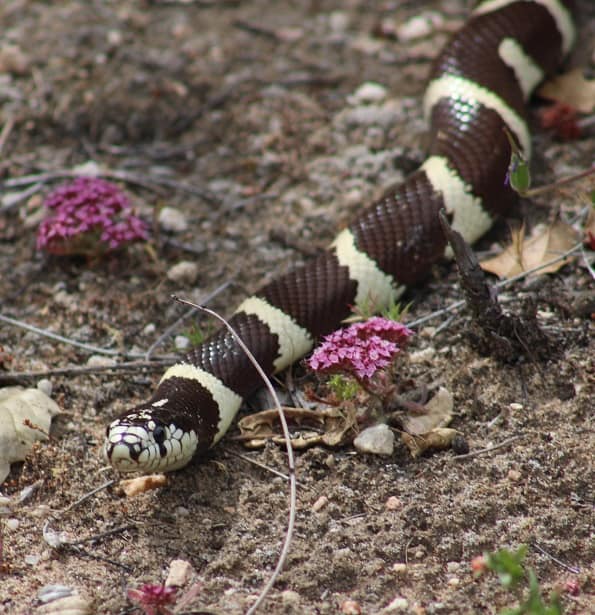
This is an extremely adventurous species, which eats mammals, snakes, and lizards alike, and prowls around the lush California countryside, constantly flecking its tongue, and attempting to pick up any scent trail which offers clues. So it’s no surprise that they’re often found in backyard swimming pools, on the warm tiles adjacent, or on metallic gates peering down.
California kingsnakes aren’t aquatic, yet are flexible enough to swim across water bodies when need be. This is a non-venomous constrictor, which has the most disproportionately strong constriction powers of any snake (beating ratsnakes), but is still nothing to fear.
As usual though, your pool neighbours probably won’t know they’re harmless. While practising your underwater swimming, equipped with goggles and swimming several lengths while barely breathing, you might submerge to find that everyone is suddenly gone. Confused, you might turn around 180 degrees and come face to face with a floating kingsnake.
Alternatively, you could leave the pool for a brief moment to visit the restroom. When you return, the pool might be empty once again, everyone having fled, with the sole occupant being a small black and white serpent, which you only notice after diving back in.
| 10 | Red-naped snake |
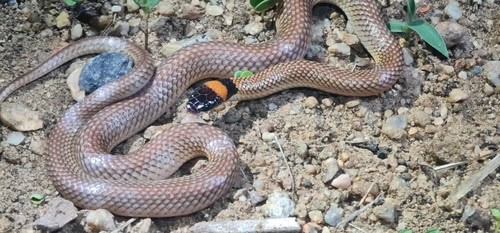
Red-naped snakes (Furina diadema) are the Australian equivalent of DeKay’s brown snake. They’re a humble snake measuring just 45cm, which often lurks under sheet metal or rubbish piles in urban areas, and occasionally gets adventurous, before going too far and landing in swimming pools. This species is common in the suburbia of Brisbane, where they can gather in small groups of 6-8.
Many eastern Australians have had to rescue red-naped snakes from swimming pools. At just 45cm, everything about the pool must seem enormous to this snake. If the pool had a walk in shallow end which grows gradually deeper, it would feel like entering the ocean. The pool probably feels the size of a small bay or tourist beach.
The same would be true for waves – if a guy jumped in without noticing the red-naped snake, the resulting wave would feel like the size of a small tsunami. Of course, if the pool has steep borders on all sides, red-naped snakes are so small that they can easily become stranded. Luckily, their venom is only mild, and bites are very rare, but caution is still advised.
